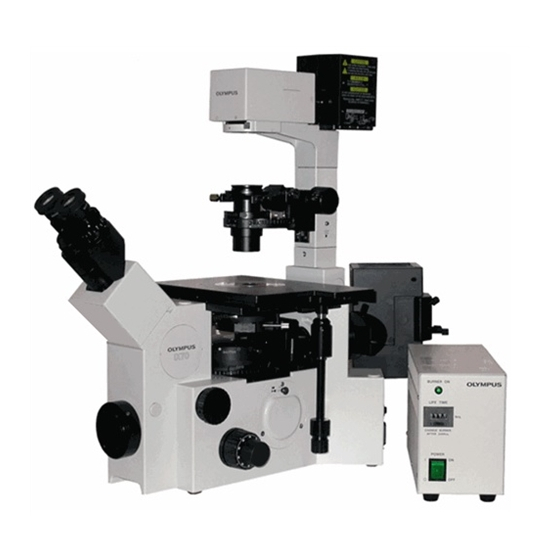Olympus IX70 Instrukcja obsługi - Strona 6
Przeglądaj online lub pobierz pdf Instrukcja obsługi dla Mikroskop Olympus IX70. Olympus IX70 32 stron. Inverted fluorescent microscope
Również dla Olympus IX70: Instrukcja obsługi (5 strony)

can also be layered on top of the media to prevent evaporation without image distortion. DO NOT USE
SILICON OIL WITH THE WARNER DISHES! It will ruin the rubber gaskets and cause leaks.
We have added a transmitted light shutter to gain better control of DIC capture and
fluorescence sequences. The brightfield bulb can be turned on with the power switch and button and set
to the desired brightness with the intensity slider, and then controlled with the shutter. The shutter opens
automatically when the DIC button is selected and closes when a fluorescence button is selected or once
an image is collected. There appears some resistance of program control vs. manual microscope control
where you may have to hit the power-on button and scroll voltage up and then try the power button again
to get the lamp to behave (it will perform once you show it who's boss, I guess; It's a MM bug. This isn't
an issue in MetaFluor software).
Fluorescence:
It's important that no other electronics be powered up when firing the arc lamp; it can
create a power surge that will fry other components (a very bad thing). Since this is a manual microscope,
choices in the software require changes to the microscope that must be made by hand. We have added
pop-up window prompts to MetaMorph to guide you in changing filter cubes, etc. Fluorescence uses
excitation filters to excite your probe(s) with a narrow band of wavelengths, a dichroic mirror to reflect
the excitation onto your sample while allowing the longer fluorescence to pass trough, and a barrier (AKA
emission) filter to block stray excitation light and limit the output color. Most filter cubes use dedicated
excitation and emission (barrier) filters. This is the case with the DAPI, FITC (wide) and Cy3 cubes in
the turret. These filters will work for both the camera and the oculars (by eye or by image). A few cubes
(like fura-2, and the cubes in the "FRET" set) require proper exciters or barrier filters to be set by the
filter wheels (Sutter controller) through the software. These filters also work by both by eye or by camera.
However, the new quad mirror requires the filter to be changed thought the software. It will image DAPI,
FITC (narrow), Cy3 or Cy5, depending on the taskbar button selected, but it will ONLY work through the
camera. You will NOT see anything by eye but a lot of very bright light!! Use the single color cubes to
find your sample and only use the quad if you need Cy5 or if you are capturing multiple wavelengths with
the Acquire Multiple Wavelengths dialog. Regardless of the filters used, it's highly recommended
that changes of all filter cubes (for the color of fluorescence) be initiated through the taskbar.
To choose a color channel, click the taskbar button for the wavelength you want, then
follow the on-screen prompt or filter list to rotate the manual filter turret under the objectives to the
correct position (see "filter wheel," Fig. 1 and 2). Press "Continue" on the pop-up window to toggle the
shutter (if necessary). Alternatively, you can learn the settings of the Sutter Lambda 10-2 filter changer
box located to the right of the microscope (long, bottom-most controller with keypad). Be aware that not
setting the exciter or emitter filters correctly can blast your sample, or worse, your poor eyes, with the full
arc lamp output. The Sutter filter changer operates a shutter to
limit illumination to actual image collection (to minimize
sample bleaching and phototoxicity), a high-speed excitation
filter changer, and a high-speed emission (camera-side) filter
changer. {optional reading /details}
control (parallel port). Manual mode requires you to press the "Local"
button on the top right of the keypad. Press either "F1" of "F2" to select a
filter changer to command. Note that the shutter is on F1; pressing the
"shutter" will toggle the light on/off. The other keys address the ten filter
positions per wheel (numbered 0 through 9).
PDF Created with deskPDF PDF Writer - Trial :: http://www.docudesk.com
By default, it is under computer
1% slider
25% slider
Fig. 4 Neutral density filters
6
